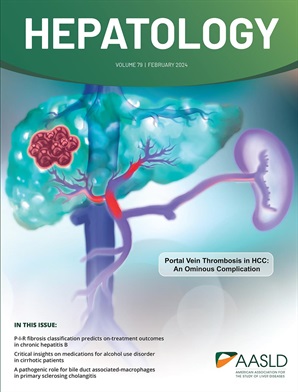Glutamine synthetase loss in β-catenin-mutant hepatocellular carcinoma promotes tumor burden through macrophage metabolic reprogramming.
IF 15.8
1区 医学
Q1 GASTROENTEROLOGY & HEPATOLOGY
引用次数: 0
Abstract
BACKGROUND AIMS Activating β-catenin gene (CTNNB1) mutations are seen in 30% of all hepatocellular cancer (HCC). These tumors are a molecularly distinct subclass characterized in majority of cases by the presence of tumor-wide glutamine synthetase (GS), increased glutamine, mTOR activation, and susceptibility to mTOR inhibitors. Here, we investigate impact of GS loss from β-catenin-mutated HCCs. APPROACH TCGA was assessed for CTNNB1-mutated HCCs with differential Glul (encoding GS) expression for survival. Glul was conditionally deleted from hepatocytes and/or macrophages in HCCs co-expressing mutant-CTNNB1 (T41A) and mutant Nrf2 in mice. Macrophage depletion was also performed by Clodranate treatment. Tumors were characterized by histology and single cell spatial transcriptomics. RESULTS CTNNB1-mutated HCC patients with low Glul showed poor survival. β-Catenin-mutated HCCs lacking GS exhibited aggressive disease due to altered glutamate/glutamine availability, forcing metabolic adaptation through upregulation of macrophage Glul permitting mTOR activation and susceptibility to mTOR inhibitors, but switching macrophage function from immunosurveillance to immunosuppression. Glul loss from tumors did not interfere with β-catenin-dependent tumor zonation and responsiveness to β-catenin inhibition. Depleting macrophages using clodronate or conditionally deleting Glul from macrophages in GS-deficient, β-catenin-mutant HCCs, both decreased tumor burden and improved survival. CONCLUSIONS We demonstrate unique metabolic dependency of β-catenin-mutated HCCs on GS in tumor cells which is diverted to macrophages upon GS elimination in tumor cells. This adaptation alters macrophage metabolism and function leading to compromised immunosurveillance and greater tumor burden. Our study reveals a metabolic dynamic between HCC cells and macrophages with impact on tumor biology.β-连环蛋白突变型肝癌中谷氨酰胺合成酶缺失通过巨噬细胞代谢重编程促进肿瘤负荷。
激活β-连环蛋白基因(CTNNB1)突变见于30%的肝细胞癌(HCC)。这些肿瘤是一个分子上独特的亚类,其特征是在大多数病例中存在肿瘤范围内的谷氨酰胺合成酶(GS)、谷氨酰胺增加、mTOR激活和对mTOR抑制剂的易感性。在这里,我们研究了β-连环蛋白突变的hcc对GS损失的影响。方法评估tcga在ctnnb1突变hcc中差异gll(编码GS)表达的生存率。在小鼠共表达突变体ctnnb1 (T41A)和突变体Nrf2的hcc中,gll从肝细胞和/或巨噬细胞中有条件地缺失。氯地酸也用于巨噬细胞清除。肿瘤通过组织学和单细胞空间转录组学进行表征。结果sctnnb1突变的低glu HCC患者生存率较差。由于谷氨酸/谷氨酰胺可用性改变,缺乏GS的β- catenin突变的hcc表现出侵袭性疾病,通过上调巨噬细胞glu迫使代谢适应,允许mTOR激活和对mTOR抑制剂的敏感性,但将巨噬细胞功能从免疫监视转变为免疫抑制。肿瘤中glu的丢失不会干扰β-catenin依赖的肿瘤分区和对β-catenin抑制的反应。在gs缺陷、β-catenin突变的hcc中,使用氯膦酸盐消耗巨噬细胞或有条件地从巨噬细胞中删除glu,既可以降低肿瘤负荷,又可以提高生存率。结论:β-catenin突变的hcc对肿瘤细胞中的GS具有独特的代谢依赖性,当GS在肿瘤细胞中被消除后,这种依赖性会转移到巨噬细胞中。这种适应改变了巨噬细胞的代谢和功能,导致免疫监测受损和更大的肿瘤负担。我们的研究揭示了HCC细胞和巨噬细胞之间的代谢动态对肿瘤生物学的影响。
本文章由计算机程序翻译,如有差异,请以英文原文为准。
求助全文
约1分钟内获得全文
求助全文
来源期刊

Hepatology
医学-胃肠肝病学
CiteScore
27.50
自引率
3.70%
发文量
609
审稿时长
1 months
期刊介绍:
HEPATOLOGY is recognized as the leading publication in the field of liver disease. It features original, peer-reviewed articles covering various aspects of liver structure, function, and disease. The journal's distinguished Editorial Board carefully selects the best articles each month, focusing on topics including immunology, chronic hepatitis, viral hepatitis, cirrhosis, genetic and metabolic liver diseases, liver cancer, and drug metabolism.
 求助内容:
求助内容: 应助结果提醒方式:
应助结果提醒方式:


